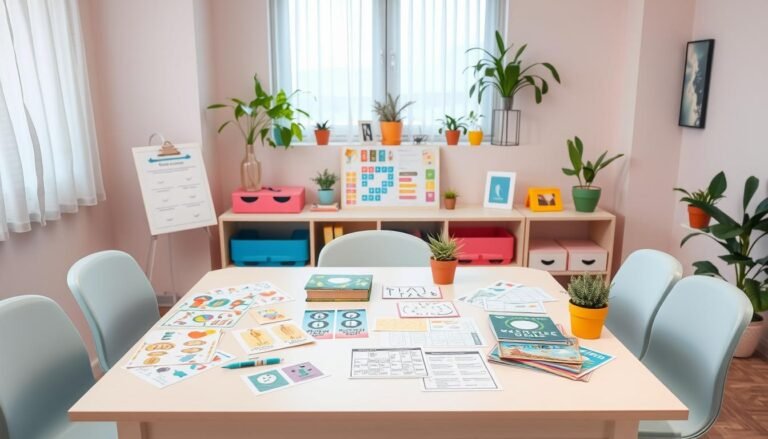
Did you know that 90% of online ESL companies use demo classes as a key part of their hiring process? This surprising statistic highlights the critical role of ESL demo classes in the world of English language learning and online tutoring. As I dive into the realm of teaching English as a foreign language online, I’m amazed by how crucial these demo sessions have become.
The surge in popularity of online ESL teaching has transformed the landscape of education. It’s not just about convenience anymore; it’s a global phenomenon that’s reshaping how we approach language learning. From my experience, I’ve seen firsthand how these demo classes serve as virtual interviews, assessing both potential and professionalism of aspiring tutors.
What’s fascinating is the variety of these demo classes. Some involve adult students, while others feature child-acting adults or even real 6-year-olds! This diversity challenges teachers to adapt their skills across different age groups and learning styles. In my journey, I’ve learned that time management is key – ending a lesson appropriately can make or break your demo performance.
The world of online ESL teaching isn’t just about language skills. It’s a unique blend of education and entertainment. I’ve found that using props, rewards, and interactive activities like action songs can transform a ordinary lesson into an engaging learning experience. It’s all about finding that sweet spot between fun and learning to keep students focused and motivated.
To succeed in an ESL demo class, having the right teaching aids and resources on hand can make a huge difference. Tools such as visual props and interactive flashcards are excellent for engaging young learners. Using headsets with noise-cancellation and a reliable HD webcam enhances your online presence and improves communication with students, ensuring your voice is clear and free from distractions. For lesson planning, printable grammar worksheets or vocabulary charts make it easy to address different language skills effectively, helping students retain the material long-term.
Disclosure: Some of the links in this post are affiliate links, which means that if you make a purchase through them, I may earn a small commission at no additional cost to you. I only recommend products that I believe will genuinely help you in your journey to earn money from home. These commissions allow me to keep creating helpful content and sharing practical advice, so thank you for supporting my blog!
Key Takeaways
- ESL demo classes are crucial in the hiring process for online tutoring positions
- Time management and adaptability are essential skills for successful demo classes
- Different approaches are needed for teaching adults versus children in online settings
- Interactive tools and activities enhance student engagement in virtual classrooms
- Balancing education and entertainment is key to effective online ESL teaching
What is an ESL Demo Class?
An ESL demo class is a short teaching session where instructors showcase their skills and teaching style. These classes typically last around 30 minutes and play a crucial role in hiring online English teaching jobs. As an aspiring teacher, I’ve learned that demo classes are my chance to shine and demonstrate my ability to engage learners effectively.
Definition and Purpose
Demo classes serve as a practical assessment for potential employers or students. They come in two main types: teaching a simulated class or instructing real students. The primary goal is to exhibit how well I can present material, manage a classroom environment, and incorporate essential elements like conversational practice and pronunciation exercises.
Importance for Aspiring Teachers
For me and other aspiring ESL teachers, demo classes are a critical step in landing a job. They provide valuable experience and help us stand out. I’ve found that preparation is key – reviewing materials, preparing props, and understanding lesson objectives are all crucial. Companies often provide guidelines and materials at least 24 hours before the scheduled demo, giving me time to polish my performance.
During these sessions, I focus on balancing teacher talk time with student talk time, adapting to the student’s language level. I make sure to use at least two props and incorporate engaging activities that showcase my ability to lead conversational practice and pronunciation exercises. By demonstrating key teacher qualities, I can potentially secure a higher hourly rate when hired.
Key Elements of a Successful ESL Demo Class
As an ESL teacher, I know that a successful demo class can make or break your chances of landing a teaching job. Let’s dive into the essential components that will help you shine during your demo.
Lesson Planning
A well-structured lesson plan is crucial. I always start by choosing a central topic to avoid appearing disorganized. For beginners, I might focus on basic vocabulary games, while advanced learners benefit from exploring the nuances between formal and informal language. Grammar lessons and vocabulary building activities should be seamlessly integrated into your plan.

Engaging Activities
Interactive teaching methods are key to keeping students involved. I love using role-plays, multimedia resources, and games to make learning fun. Remember, schools are looking for dynamic teachers who can create an enjoyable experience for students.
Classroom Management Techniques
Effective classroom management showcases your ability to handle potential challenges. I make sure to arrive early to assess the room and equipment. During the demo, I maintain eye contact, use clear gestures, and project my voice confidently. Time management is crucial – I always ensure all planned activities fit within the allotted time.
| Demo Class Element | Importance | Tips |
|---|---|---|
| Lesson Planning | High | Focus on one central topic |
| Engaging Activities | Critical | Use games, role-plays, multimedia |
| Classroom Management | Essential | Arrive early, manage time effectively |
By focusing on these key elements, you’ll be well-prepared to deliver a standout ESL demo class that showcases your teaching skills and personality.
Preparing for Your ESL Demo Class
Getting ready for an ESL demo class requires careful planning and practice. I’ll share some key strategies to help you create an immersive learning experience that showcases your teaching skills.
Researching Your Audience
Understanding your students is crucial. ESL companies often provide information about the age group and proficiency level you’ll be teaching. Use this to tailor your lesson. For instance, if you’re teaching young learners, incorporate more visual aids and interactive activities.

Selecting Appropriate Materials
Choose materials that support interactive lessons. Most companies provide lesson plans, but you can enhance them with props. Remember, 8-10 minutes is the average demo lesson duration, so pick 2-3 engaging activities. Use colorful flashcards, realia, or digital tools to create an immersive learning environment.
Practicing Your Delivery
Practice makes perfect! Run through your lesson multiple times to ensure smooth transitions. Time yourself to stay within the 8-20 minute range most companies expect. Pay attention to your speaking pace and clarity. Record yourself to identify areas for improvement in your delivery and body language.
“Preparation is the key to confidence. The more you practice, the more natural and engaging your demo class will be.”
Don’t forget to check your tech setup. Good lighting, a stable internet connection, and a quality headset with microphone are essential for online demos. A clean, organized teaching space projects professionalism and helps create an immersive learning atmosphere for your students.
Best Practices for Demonstrating Teaching Skills
Mastering the art of teaching requires a blend of communication skills, tech savvy, and student engagement. In my experience, these elements are crucial for success in ESL demo classes and online tutoring sessions.
Showcasing Communication Skills
Clear and effective communication is the cornerstone of great teaching. I’ve found that speaking at an appropriate pace and using gestures can significantly enhance understanding. Cultural exposure plays a vital role too. By incorporating diverse examples, I create an inclusive environment that resonates with students from various backgrounds.
Utilizing Technology
In today’s digital age, leveraging technology is a game-changer. I often use interactive whiteboards and multimedia presentations to make lessons more engaging. For online tutoring, screen sharing and virtual breakout rooms have proven invaluable for collaborative activities.

Encouraging Student Interaction
Active participation is key to effective learning. I implement strategies like think-pair-share and group discussions to foster interaction. These methods not only boost engagement but also provide opportunities for cultural exposure as students share diverse perspectives.
| Teaching Skill | Implementation Strategy | Benefits |
|---|---|---|
| Communication | Clear speech, appropriate pacing | Enhanced understanding, reduced confusion |
| Technology Use | Interactive whiteboards, multimedia | Increased engagement, visual learning |
| Student Interaction | Group discussions, pair work | Active participation, peer learning |
By focusing on these best practices, I’ve seen significant improvements in student engagement and learning outcomes in both traditional and online tutoring settings.
How to Handle Q&A Sessions Effectively
Q&A sessions are crucial for Conversational Practice in English Language Learning. They offer a chance to showcase your teaching skills and interact with students. I’ll share some tips to help you excel in these sessions.
Anticipating Common Questions
Prepare for questions about lesson content and ESL teaching methods. Research common language learning challenges. This preparation helps you address student concerns confidently.

Responding with Confidence
When answering questions, speak clearly and maintain eye contact. Use simple language and provide examples to clarify your points. If you’re unsure about an answer, it’s okay to say, “Let me look into that and get back to you.”
Managing Different Student Responses
Encourage participation from all students. Praise efforts and gently correct errors. Use group activities to boost Conversational Practice. Here’s a strategy I find effective:
- Assign roles based on language ability
- Promote students to new roles as they improve
- Ensure everyone understands the importance of their contributions
- Balance participation among students
Remember, effective Q&A sessions enhance English Language Learning. They create a supportive environment where students feel comfortable practicing their skills.
Evaluating Your ESL Demo Performance
After completing your ESL demo class, it’s crucial to assess your performance. This evaluation helps refine your teaching skills, especially in areas like pronunciation exercises and grammar lessons. Let’s explore some effective ways to analyze your demo and identify areas for growth.
Self-Assessment Techniques
I always start by recording my demo lessons. This allows me to review my performance objectively. While watching, I pay close attention to my pacing, clarity of instructions, and use of Total Physical Response (TPR). I also evaluate how well I incorporated pronunciation exercises and grammar lessons into the demo.
Seeking Feedback from Peers
Peer feedback is invaluable. I often ask colleagues to observe my recorded demos. Their insights help me spot blind spots in my teaching approach. They might notice things I missed, like opportunities for better student engagement or areas where I could improve my grammar explanations.
Identifying Areas for Improvement
Based on self-assessment and peer feedback, I create a list of areas to work on. This might include enhancing my pronunciation exercises, refining my grammar lessons, or improving my use of technology in the classroom. I set specific goals for each area and track my progress over time.
| Assessment Area | Self-Score (1-5) | Peer Score (1-5) | Improvement Plan |
|---|---|---|---|
| Pronunciation Exercises | 4 | 3 | Incorporate more varied exercises |
| Grammar Lessons | 3 | 4 | Use more interactive methods |
| Student Engagement | 4 | 4 | Add more group activities |
| Use of Technology | 3 | 3 | Explore new educational apps |
Remember, continuous improvement is key in ESL teaching. By regularly evaluating your demo performance, you’ll enhance your skills and become a more effective educator.
Real-Life Examples of ESL Demo Classes
I’ve examined numerous ESL demo classes to bring you insights from successful educators. These real-life examples showcase effective strategies for Vocabulary Building and Immersive Learning. Let’s dive into some case studies and lessons learned from experience.
Case Studies from Successful Educators
One standout demo class focused on very young learners. The teacher engaged a group of 30 children in a 15-minute lesson on body parts. Using Total Physical Response (TPR) and puppets, she created an immersive environment for Vocabulary Building. The kids were fully engaged, singing songs and responding to commands.
Another impressive demo targeted adult learners. In a 20-minute session, the instructor used a coursebook to teach transport vocabulary. He incorporated e-books and images, demonstrating how technology can enhance Immersive Learning. The lesson flowed smoothly from presentation to practice, keeping students actively involved.
Lessons Learned from Experience
Experienced educators emphasize the importance of impressing interviewers within the first 3 minutes. They look for teacher charisma and clear lesson planning. Here’s a table summarizing key takeaways:
| Age Group | Effective Strategies | Common Pitfalls |
|---|---|---|
| Very Young Learners | TPR, puppets, songs | Overcomplicating activities |
| Teens | Role-plays, flashcards | Lack of behavior management |
| Adults | E-books, functional language | Insufficient challenge for advanced learners |
Remember, successful demos balance Vocabulary Building with Immersive Learning techniques. Tailor your approach to your audience, and always have a clear, manageable lesson plan.
Tips for Overcoming Nervousness
Feeling jittery before an ESL demo class is normal. I’ve found that mastering a few techniques can transform that nervous energy into enthusiasm for interactive lessons. Let’s explore some strategies to boost your confidence and shine in your demo.
Breathing Techniques
Deep breathing is my go-to method for calming nerves. I take slow, deep breaths, counting to four as I inhale and exhale. This simple practice helps me center my thoughts and relax my body before stepping into the classroom.
Visualization Strategies
I picture myself confidently leading a successful class, engaging students in cultural exposure activities. This positive imagery helps me feel more prepared and excited about the upcoming demo.
Building Confidence Through Preparation
Thorough preparation is key to feeling confident. I create detailed lesson plans, practice my delivery, and anticipate potential questions. This readiness allows me to focus on creating engaging, interactive lessons rather than worrying about what might go wrong.
Remember, some nervousness is natural and can be channeled into positive energy. By focusing on your passion for teaching and connecting with students, you’ll be well-equipped to deliver an impressive demo class.
| Technique | Benefit | Implementation |
|---|---|---|
| Deep Breathing | Reduces anxiety | 4-count inhale/exhale |
| Visualization | Boosts confidence | Imagine successful outcomes |
| Preparation | Enhances readiness | Create detailed lesson plans |
Next Steps After Your ESL Demo Class
After completing my ESL demo class, I’m ready to take the next steps in my teaching journey. The demo is just the beginning of a rewarding career in online tutoring. I’ve learned that most companies provide lesson materials and inform about student age and English ability, which helps me prepare effectively.
Following Up with Feedback
I always seek feedback after my ESL demo class. It’s crucial for my growth as an educator. Companies typically inform candidates about demo lesson expectations in advance. This feedback can significantly impact my hourly rate if I’m hired, so I take it seriously.
Continuous Development as a Teacher
To excel in online tutoring, I focus on continuous improvement. I’ve discovered that many companies look for similar teacher qualities in demo lessons. I keep my equipment reliable and maintain a strong internet connection. I also pay attention to dress codes, as preferences vary among companies. For instance, UUabc prefers blue, while Dada and SayABC lean towards sky blue.
Networking Opportunities in ESL Education
Networking is key in the ESL world. I’ve learned that about 50% of an ESL demo class is spent explaining vocabulary and engaging students in activities. This insight helps me connect with other educators and share experiences. By staying connected, I can adapt my teaching approach to include more specific language elements like grammar or idioms, enhancing learning outcomes for advanced students in future ESL demo classes.






